CAPCO: Organizational Behavior Report - Leadership and Culture
VerifiedAdded on 2020/02/03
|24
|6493
|333
Report
AI Summary
This report provides an in-depth analysis of CAPCO's organizational behavior, encompassing its structure, culture, and the factors influencing individual and team performance. The report begins by examining different organizational structures, such as hierarchical, flat, and matrix structures, and contrasting them with CAPCO's flat structure. It further explores various organizational cultures, including normative, academy, pragmatic, and club cultures, highlighting CAPCO's academic culture. The report then delves into the relationship between organizational structure and culture, emphasizing how they impact decision-making, employee benefits, and hiring practices. It also discusses the factors that affect individual behavior in the workplace, such as leadership, skills, work culture, attitude, and their influence on achieving competitive advantage. The report evaluates different leadership styles, including autocratic, laissez-faire, participative, and democratic, used within CAPCO. Finally, the report assesses the factors that promote or inhibit effective teamwork, offering insights into enhancing team performance within the organization.
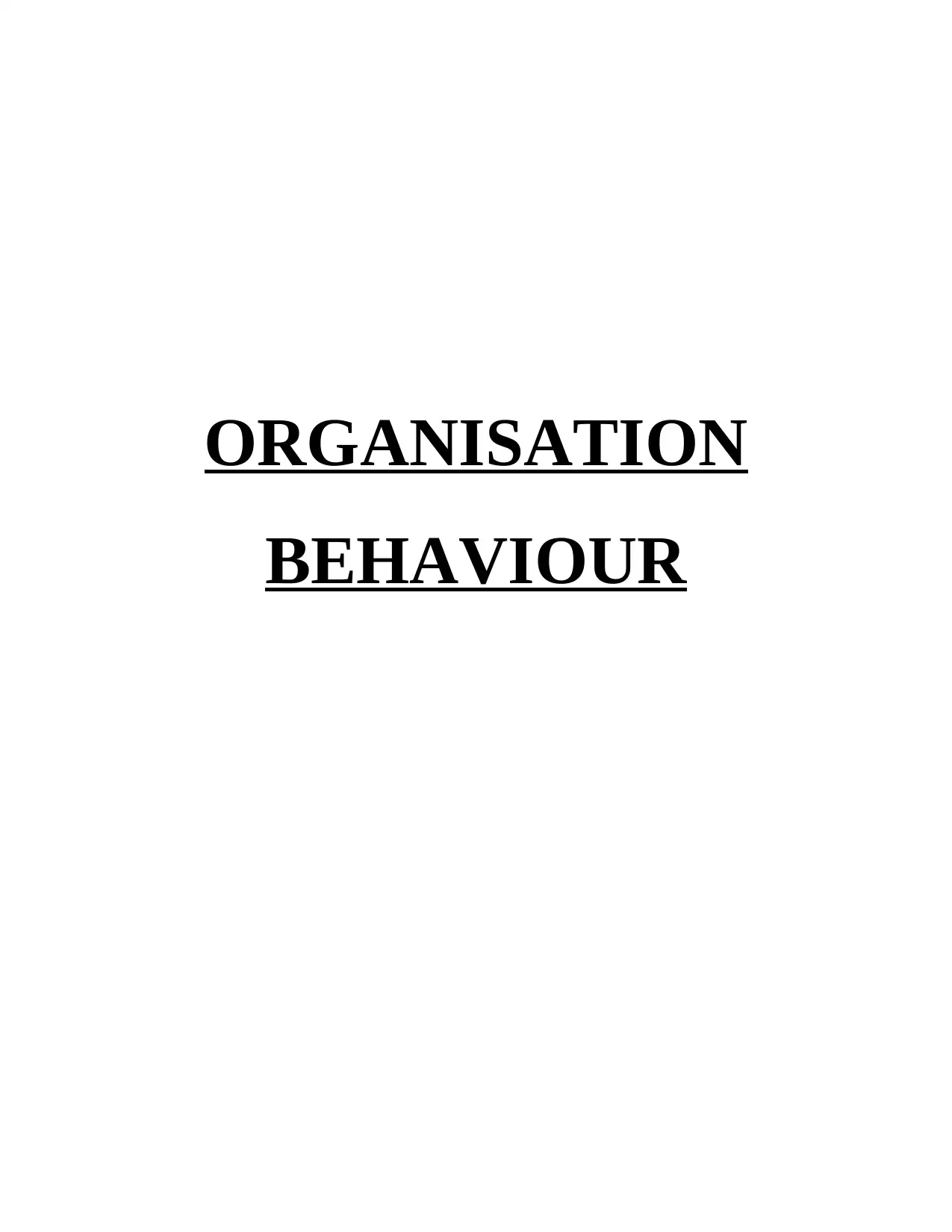
ORGANISATION
BEHAVIOUR
BEHAVIOUR
Paraphrase This Document
Need a fresh take? Get an instant paraphrase of this document with our AI Paraphraser
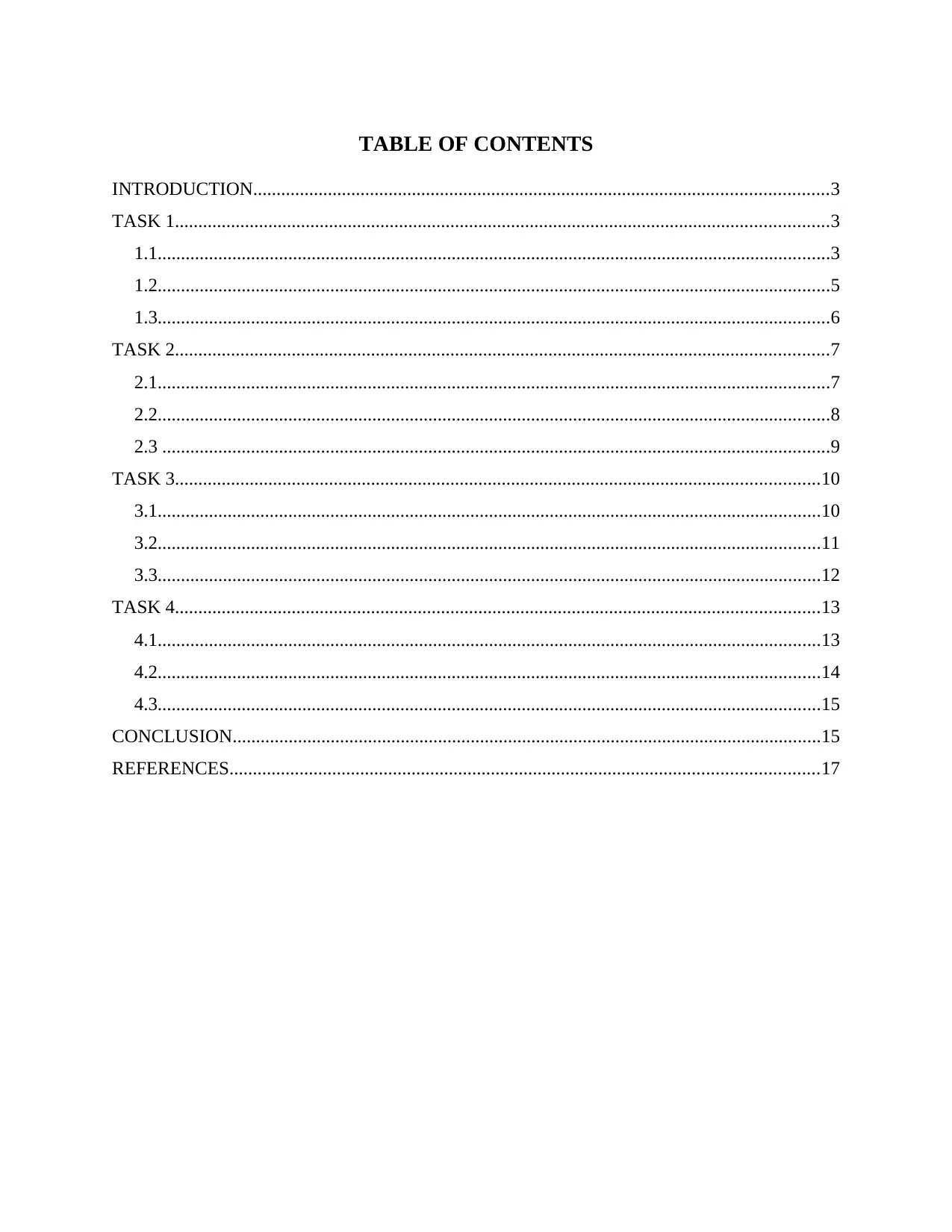
TABLE OF CONTENTS
INTRODUCTION...........................................................................................................................3
TASK 1............................................................................................................................................3
1.1................................................................................................................................................3
1.2................................................................................................................................................5
1.3................................................................................................................................................6
TASK 2............................................................................................................................................7
2.1................................................................................................................................................7
2.2................................................................................................................................................8
2.3 ...............................................................................................................................................9
TASK 3..........................................................................................................................................10
3.1..............................................................................................................................................10
3.2..............................................................................................................................................11
3.3..............................................................................................................................................12
TASK 4..........................................................................................................................................13
4.1..............................................................................................................................................13
4.2..............................................................................................................................................14
4.3..............................................................................................................................................15
CONCLUSION..............................................................................................................................15
REFERENCES..............................................................................................................................17
INTRODUCTION...........................................................................................................................3
TASK 1............................................................................................................................................3
1.1................................................................................................................................................3
1.2................................................................................................................................................5
1.3................................................................................................................................................6
TASK 2............................................................................................................................................7
2.1................................................................................................................................................7
2.2................................................................................................................................................8
2.3 ...............................................................................................................................................9
TASK 3..........................................................................................................................................10
3.1..............................................................................................................................................10
3.2..............................................................................................................................................11
3.3..............................................................................................................................................12
TASK 4..........................................................................................................................................13
4.1..............................................................................................................................................13
4.2..............................................................................................................................................14
4.3..............................................................................................................................................15
CONCLUSION..............................................................................................................................15
REFERENCES..............................................................................................................................17
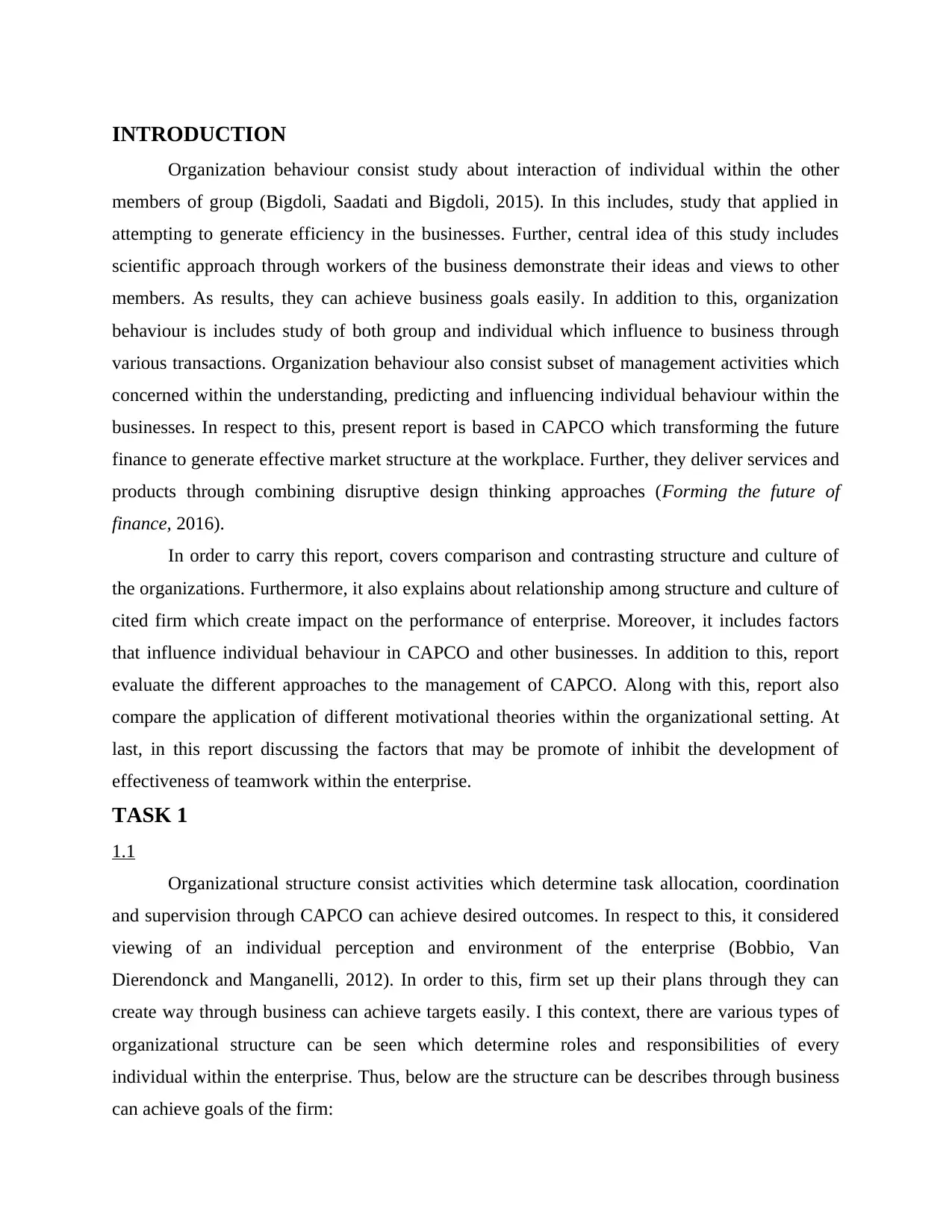
INTRODUCTION
Organization behaviour consist study about interaction of individual within the other
members of group (Bigdoli, Saadati and Bigdoli, 2015). In this includes, study that applied in
attempting to generate efficiency in the businesses. Further, central idea of this study includes
scientific approach through workers of the business demonstrate their ideas and views to other
members. As results, they can achieve business goals easily. In addition to this, organization
behaviour is includes study of both group and individual which influence to business through
various transactions. Organization behaviour also consist subset of management activities which
concerned within the understanding, predicting and influencing individual behaviour within the
businesses. In respect to this, present report is based in CAPCO which transforming the future
finance to generate effective market structure at the workplace. Further, they deliver services and
products through combining disruptive design thinking approaches (Forming the future of
finance, 2016).
In order to carry this report, covers comparison and contrasting structure and culture of
the organizations. Furthermore, it also explains about relationship among structure and culture of
cited firm which create impact on the performance of enterprise. Moreover, it includes factors
that influence individual behaviour in CAPCO and other businesses. In addition to this, report
evaluate the different approaches to the management of CAPCO. Along with this, report also
compare the application of different motivational theories within the organizational setting. At
last, in this report discussing the factors that may be promote of inhibit the development of
effectiveness of teamwork within the enterprise.
TASK 1
1.1
Organizational structure consist activities which determine task allocation, coordination
and supervision through CAPCO can achieve desired outcomes. In respect to this, it considered
viewing of an individual perception and environment of the enterprise (Bobbio, Van
Dierendonck and Manganelli, 2012). In order to this, firm set up their plans through they can
create way through business can achieve targets easily. I this context, there are various types of
organizational structure can be seen which determine roles and responsibilities of every
individual within the enterprise. Thus, below are the structure can be describes through business
can achieve goals of the firm:
Organization behaviour consist study about interaction of individual within the other
members of group (Bigdoli, Saadati and Bigdoli, 2015). In this includes, study that applied in
attempting to generate efficiency in the businesses. Further, central idea of this study includes
scientific approach through workers of the business demonstrate their ideas and views to other
members. As results, they can achieve business goals easily. In addition to this, organization
behaviour is includes study of both group and individual which influence to business through
various transactions. Organization behaviour also consist subset of management activities which
concerned within the understanding, predicting and influencing individual behaviour within the
businesses. In respect to this, present report is based in CAPCO which transforming the future
finance to generate effective market structure at the workplace. Further, they deliver services and
products through combining disruptive design thinking approaches (Forming the future of
finance, 2016).
In order to carry this report, covers comparison and contrasting structure and culture of
the organizations. Furthermore, it also explains about relationship among structure and culture of
cited firm which create impact on the performance of enterprise. Moreover, it includes factors
that influence individual behaviour in CAPCO and other businesses. In addition to this, report
evaluate the different approaches to the management of CAPCO. Along with this, report also
compare the application of different motivational theories within the organizational setting. At
last, in this report discussing the factors that may be promote of inhibit the development of
effectiveness of teamwork within the enterprise.
TASK 1
1.1
Organizational structure consist activities which determine task allocation, coordination
and supervision through CAPCO can achieve desired outcomes. In respect to this, it considered
viewing of an individual perception and environment of the enterprise (Bobbio, Van
Dierendonck and Manganelli, 2012). In order to this, firm set up their plans through they can
create way through business can achieve targets easily. I this context, there are various types of
organizational structure can be seen which determine roles and responsibilities of every
individual within the enterprise. Thus, below are the structure can be describes through business
can achieve goals of the firm:
⊘ This is a preview!⊘
Do you want full access?
Subscribe today to unlock all pages.

Trusted by 1+ million students worldwide
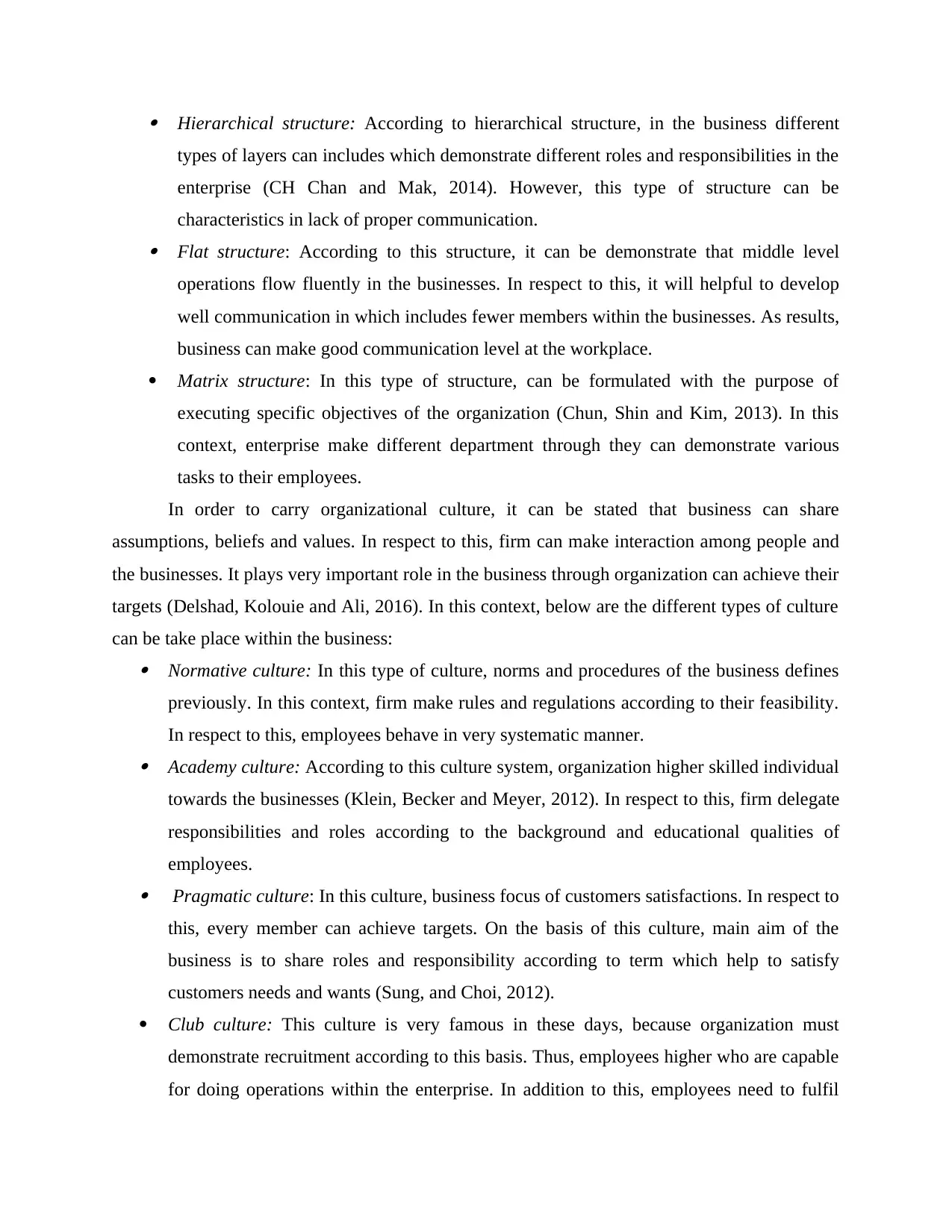
Hierarchical structure: According to hierarchical structure, in the business different
types of layers can includes which demonstrate different roles and responsibilities in the
enterprise (CH Chan and Mak, 2014). However, this type of structure can be
characteristics in lack of proper communication. Flat structure: According to this structure, it can be demonstrate that middle level
operations flow fluently in the businesses. In respect to this, it will helpful to develop
well communication in which includes fewer members within the businesses. As results,
business can make good communication level at the workplace.
Matrix structure: In this type of structure, can be formulated with the purpose of
executing specific objectives of the organization (Chun, Shin and Kim, 2013). In this
context, enterprise make different department through they can demonstrate various
tasks to their employees.
In order to carry organizational culture, it can be stated that business can share
assumptions, beliefs and values. In respect to this, firm can make interaction among people and
the businesses. It plays very important role in the business through organization can achieve their
targets (Delshad, Kolouie and Ali, 2016). In this context, below are the different types of culture
can be take place within the business: Normative culture: In this type of culture, norms and procedures of the business defines
previously. In this context, firm make rules and regulations according to their feasibility.
In respect to this, employees behave in very systematic manner. Academy culture: According to this culture system, organization higher skilled individual
towards the businesses (Klein, Becker and Meyer, 2012). In respect to this, firm delegate
responsibilities and roles according to the background and educational qualities of
employees. Pragmatic culture: In this culture, business focus of customers satisfactions. In respect to
this, every member can achieve targets. On the basis of this culture, main aim of the
business is to share roles and responsibility according to term which help to satisfy
customers needs and wants (Sung, and Choi, 2012).
Club culture: This culture is very famous in these days, because organization must
demonstrate recruitment according to this basis. Thus, employees higher who are capable
for doing operations within the enterprise. In addition to this, employees need to fulfil
types of layers can includes which demonstrate different roles and responsibilities in the
enterprise (CH Chan and Mak, 2014). However, this type of structure can be
characteristics in lack of proper communication. Flat structure: According to this structure, it can be demonstrate that middle level
operations flow fluently in the businesses. In respect to this, it will helpful to develop
well communication in which includes fewer members within the businesses. As results,
business can make good communication level at the workplace.
Matrix structure: In this type of structure, can be formulated with the purpose of
executing specific objectives of the organization (Chun, Shin and Kim, 2013). In this
context, enterprise make different department through they can demonstrate various
tasks to their employees.
In order to carry organizational culture, it can be stated that business can share
assumptions, beliefs and values. In respect to this, firm can make interaction among people and
the businesses. It plays very important role in the business through organization can achieve their
targets (Delshad, Kolouie and Ali, 2016). In this context, below are the different types of culture
can be take place within the business: Normative culture: In this type of culture, norms and procedures of the business defines
previously. In this context, firm make rules and regulations according to their feasibility.
In respect to this, employees behave in very systematic manner. Academy culture: According to this culture system, organization higher skilled individual
towards the businesses (Klein, Becker and Meyer, 2012). In respect to this, firm delegate
responsibilities and roles according to the background and educational qualities of
employees. Pragmatic culture: In this culture, business focus of customers satisfactions. In respect to
this, every member can achieve targets. On the basis of this culture, main aim of the
business is to share roles and responsibility according to term which help to satisfy
customers needs and wants (Sung, and Choi, 2012).
Club culture: This culture is very famous in these days, because organization must
demonstrate recruitment according to this basis. Thus, employees higher who are capable
for doing operations within the enterprise. In addition to this, employees need to fulfil
Paraphrase This Document
Need a fresh take? Get an instant paraphrase of this document with our AI Paraphraser
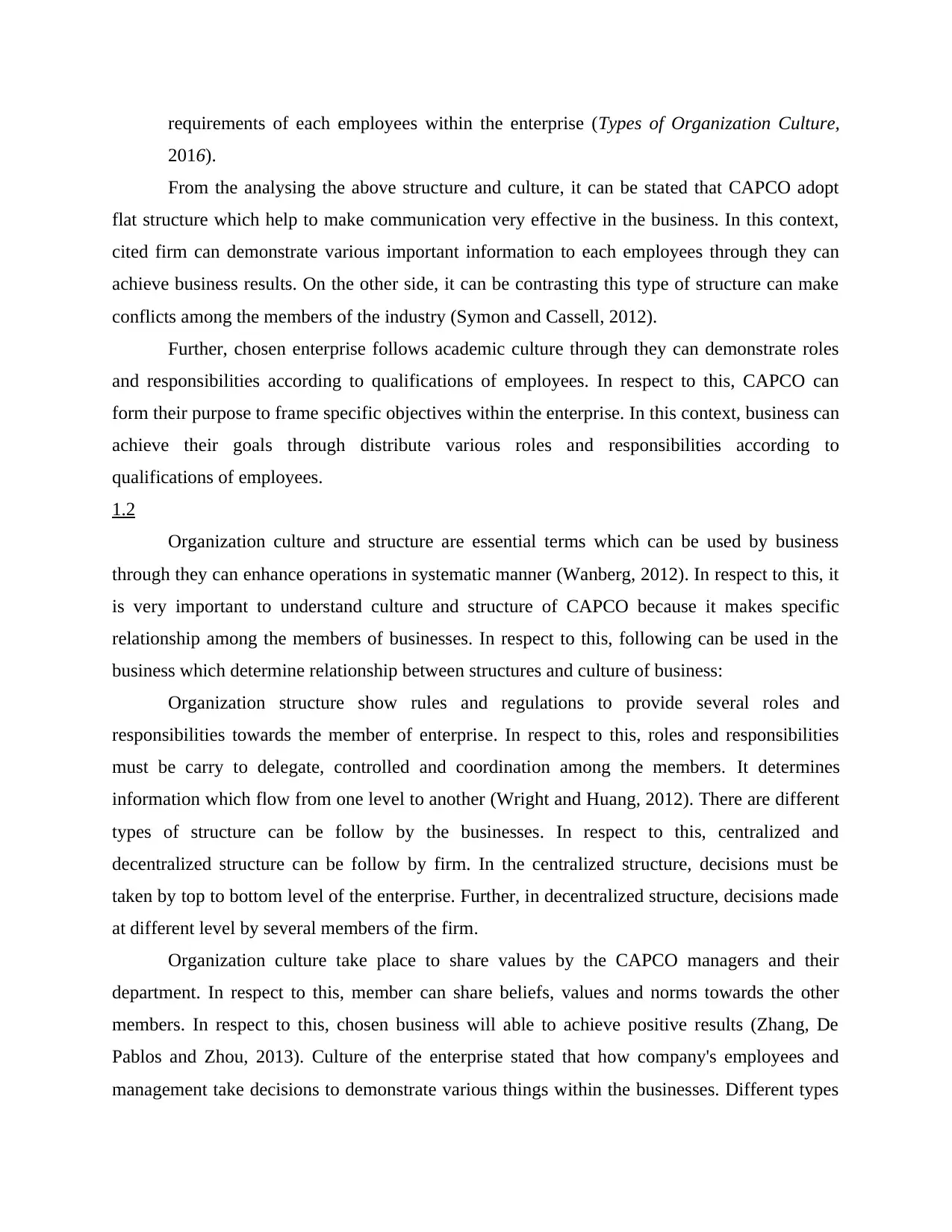
requirements of each employees within the enterprise (Types of Organization Culture,
2016).
From the analysing the above structure and culture, it can be stated that CAPCO adopt
flat structure which help to make communication very effective in the business. In this context,
cited firm can demonstrate various important information to each employees through they can
achieve business results. On the other side, it can be contrasting this type of structure can make
conflicts among the members of the industry (Symon and Cassell, 2012).
Further, chosen enterprise follows academic culture through they can demonstrate roles
and responsibilities according to qualifications of employees. In respect to this, CAPCO can
form their purpose to frame specific objectives within the enterprise. In this context, business can
achieve their goals through distribute various roles and responsibilities according to
qualifications of employees.
1.2
Organization culture and structure are essential terms which can be used by business
through they can enhance operations in systematic manner (Wanberg, 2012). In respect to this, it
is very important to understand culture and structure of CAPCO because it makes specific
relationship among the members of businesses. In respect to this, following can be used in the
business which determine relationship between structures and culture of business:
Organization structure show rules and regulations to provide several roles and
responsibilities towards the member of enterprise. In respect to this, roles and responsibilities
must be carry to delegate, controlled and coordination among the members. It determines
information which flow from one level to another (Wright and Huang, 2012). There are different
types of structure can be follow by the businesses. In respect to this, centralized and
decentralized structure can be follow by firm. In the centralized structure, decisions must be
taken by top to bottom level of the enterprise. Further, in decentralized structure, decisions made
at different level by several members of the firm.
Organization culture take place to share values by the CAPCO managers and their
department. In respect to this, member can share beliefs, values and norms towards the other
members. In respect to this, chosen business will able to achieve positive results (Zhang, De
Pablos and Zhou, 2013). Culture of the enterprise stated that how company's employees and
management take decisions to demonstrate various things within the businesses. Different types
2016).
From the analysing the above structure and culture, it can be stated that CAPCO adopt
flat structure which help to make communication very effective in the business. In this context,
cited firm can demonstrate various important information to each employees through they can
achieve business results. On the other side, it can be contrasting this type of structure can make
conflicts among the members of the industry (Symon and Cassell, 2012).
Further, chosen enterprise follows academic culture through they can demonstrate roles
and responsibilities according to qualifications of employees. In respect to this, CAPCO can
form their purpose to frame specific objectives within the enterprise. In this context, business can
achieve their goals through distribute various roles and responsibilities according to
qualifications of employees.
1.2
Organization culture and structure are essential terms which can be used by business
through they can enhance operations in systematic manner (Wanberg, 2012). In respect to this, it
is very important to understand culture and structure of CAPCO because it makes specific
relationship among the members of businesses. In respect to this, following can be used in the
business which determine relationship between structures and culture of business:
Organization structure show rules and regulations to provide several roles and
responsibilities towards the member of enterprise. In respect to this, roles and responsibilities
must be carry to delegate, controlled and coordination among the members. It determines
information which flow from one level to another (Wright and Huang, 2012). There are different
types of structure can be follow by the businesses. In respect to this, centralized and
decentralized structure can be follow by firm. In the centralized structure, decisions must be
taken by top to bottom level of the enterprise. Further, in decentralized structure, decisions made
at different level by several members of the firm.
Organization culture take place to share values by the CAPCO managers and their
department. In respect to this, member can share beliefs, values and norms towards the other
members. In respect to this, chosen business will able to achieve positive results (Zhang, De
Pablos and Zhou, 2013). Culture of the enterprise stated that how company's employees and
management take decisions to demonstrate various things within the businesses. Different types
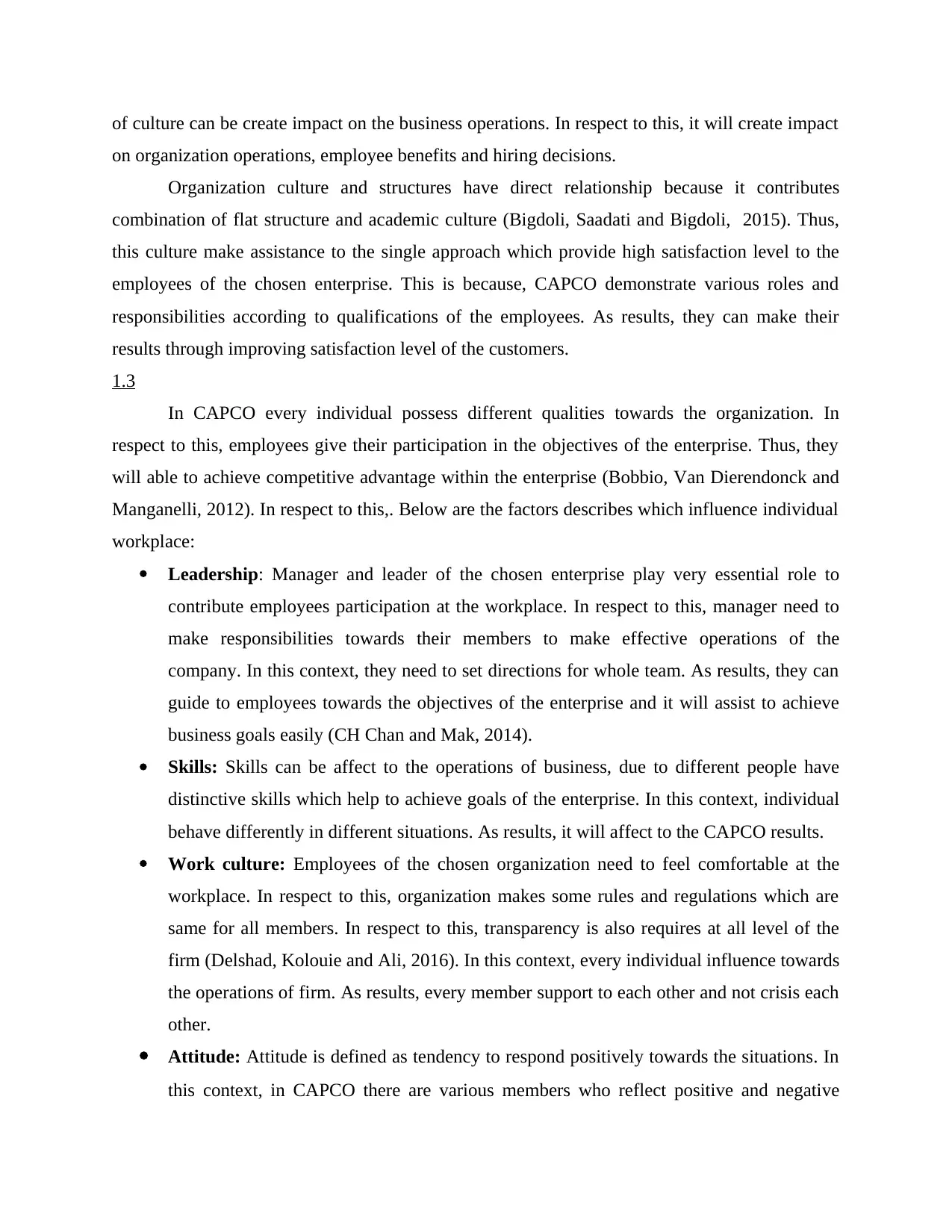
of culture can be create impact on the business operations. In respect to this, it will create impact
on organization operations, employee benefits and hiring decisions.
Organization culture and structures have direct relationship because it contributes
combination of flat structure and academic culture (Bigdoli, Saadati and Bigdoli, 2015). Thus,
this culture make assistance to the single approach which provide high satisfaction level to the
employees of the chosen enterprise. This is because, CAPCO demonstrate various roles and
responsibilities according to qualifications of the employees. As results, they can make their
results through improving satisfaction level of the customers.
1.3
In CAPCO every individual possess different qualities towards the organization. In
respect to this, employees give their participation in the objectives of the enterprise. Thus, they
will able to achieve competitive advantage within the enterprise (Bobbio, Van Dierendonck and
Manganelli, 2012). In respect to this,. Below are the factors describes which influence individual
workplace:
Leadership: Manager and leader of the chosen enterprise play very essential role to
contribute employees participation at the workplace. In respect to this, manager need to
make responsibilities towards their members to make effective operations of the
company. In this context, they need to set directions for whole team. As results, they can
guide to employees towards the objectives of the enterprise and it will assist to achieve
business goals easily (CH Chan and Mak, 2014).
Skills: Skills can be affect to the operations of business, due to different people have
distinctive skills which help to achieve goals of the enterprise. In this context, individual
behave differently in different situations. As results, it will affect to the CAPCO results.
Work culture: Employees of the chosen organization need to feel comfortable at the
workplace. In respect to this, organization makes some rules and regulations which are
same for all members. In respect to this, transparency is also requires at all level of the
firm (Delshad, Kolouie and Ali, 2016). In this context, every individual influence towards
the operations of firm. As results, every member support to each other and not crisis each
other.
Attitude: Attitude is defined as tendency to respond positively towards the situations. In
this context, in CAPCO there are various members who reflect positive and negative
on organization operations, employee benefits and hiring decisions.
Organization culture and structures have direct relationship because it contributes
combination of flat structure and academic culture (Bigdoli, Saadati and Bigdoli, 2015). Thus,
this culture make assistance to the single approach which provide high satisfaction level to the
employees of the chosen enterprise. This is because, CAPCO demonstrate various roles and
responsibilities according to qualifications of the employees. As results, they can make their
results through improving satisfaction level of the customers.
1.3
In CAPCO every individual possess different qualities towards the organization. In
respect to this, employees give their participation in the objectives of the enterprise. Thus, they
will able to achieve competitive advantage within the enterprise (Bobbio, Van Dierendonck and
Manganelli, 2012). In respect to this,. Below are the factors describes which influence individual
workplace:
Leadership: Manager and leader of the chosen enterprise play very essential role to
contribute employees participation at the workplace. In respect to this, manager need to
make responsibilities towards their members to make effective operations of the
company. In this context, they need to set directions for whole team. As results, they can
guide to employees towards the objectives of the enterprise and it will assist to achieve
business goals easily (CH Chan and Mak, 2014).
Skills: Skills can be affect to the operations of business, due to different people have
distinctive skills which help to achieve goals of the enterprise. In this context, individual
behave differently in different situations. As results, it will affect to the CAPCO results.
Work culture: Employees of the chosen organization need to feel comfortable at the
workplace. In respect to this, organization makes some rules and regulations which are
same for all members. In respect to this, transparency is also requires at all level of the
firm (Delshad, Kolouie and Ali, 2016). In this context, every individual influence towards
the operations of firm. As results, every member support to each other and not crisis each
other.
Attitude: Attitude is defined as tendency to respond positively towards the situations. In
this context, in CAPCO there are various members who reflect positive and negative
⊘ This is a preview!⊘
Do you want full access?
Subscribe today to unlock all pages.

Trusted by 1+ million students worldwide
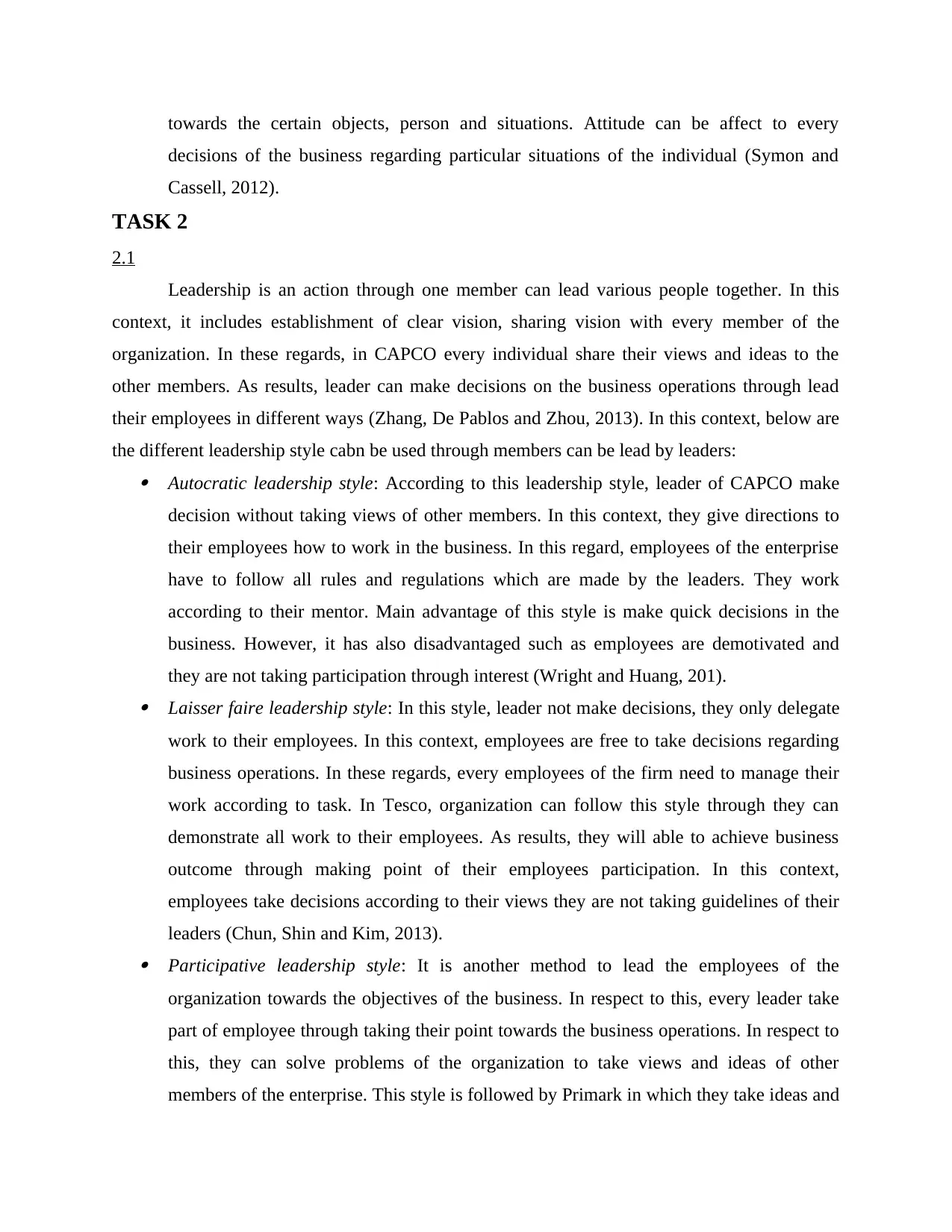
towards the certain objects, person and situations. Attitude can be affect to every
decisions of the business regarding particular situations of the individual (Symon and
Cassell, 2012).
TASK 2
2.1
Leadership is an action through one member can lead various people together. In this
context, it includes establishment of clear vision, sharing vision with every member of the
organization. In these regards, in CAPCO every individual share their views and ideas to the
other members. As results, leader can make decisions on the business operations through lead
their employees in different ways (Zhang, De Pablos and Zhou, 2013). In this context, below are
the different leadership style cabn be used through members can be lead by leaders: Autocratic leadership style: According to this leadership style, leader of CAPCO make
decision without taking views of other members. In this context, they give directions to
their employees how to work in the business. In this regard, employees of the enterprise
have to follow all rules and regulations which are made by the leaders. They work
according to their mentor. Main advantage of this style is make quick decisions in the
business. However, it has also disadvantaged such as employees are demotivated and
they are not taking participation through interest (Wright and Huang, 201). Laisser faire leadership style: In this style, leader not make decisions, they only delegate
work to their employees. In this context, employees are free to take decisions regarding
business operations. In these regards, every employees of the firm need to manage their
work according to task. In Tesco, organization can follow this style through they can
demonstrate all work to their employees. As results, they will able to achieve business
outcome through making point of their employees participation. In this context,
employees take decisions according to their views they are not taking guidelines of their
leaders (Chun, Shin and Kim, 2013). Participative leadership style: It is another method to lead the employees of the
organization towards the objectives of the business. In respect to this, every leader take
part of employee through taking their point towards the business operations. In respect to
this, they can solve problems of the organization to take views and ideas of other
members of the enterprise. This style is followed by Primark in which they take ideas and
decisions of the business regarding particular situations of the individual (Symon and
Cassell, 2012).
TASK 2
2.1
Leadership is an action through one member can lead various people together. In this
context, it includes establishment of clear vision, sharing vision with every member of the
organization. In these regards, in CAPCO every individual share their views and ideas to the
other members. As results, leader can make decisions on the business operations through lead
their employees in different ways (Zhang, De Pablos and Zhou, 2013). In this context, below are
the different leadership style cabn be used through members can be lead by leaders: Autocratic leadership style: According to this leadership style, leader of CAPCO make
decision without taking views of other members. In this context, they give directions to
their employees how to work in the business. In this regard, employees of the enterprise
have to follow all rules and regulations which are made by the leaders. They work
according to their mentor. Main advantage of this style is make quick decisions in the
business. However, it has also disadvantaged such as employees are demotivated and
they are not taking participation through interest (Wright and Huang, 201). Laisser faire leadership style: In this style, leader not make decisions, they only delegate
work to their employees. In this context, employees are free to take decisions regarding
business operations. In these regards, every employees of the firm need to manage their
work according to task. In Tesco, organization can follow this style through they can
demonstrate all work to their employees. As results, they will able to achieve business
outcome through making point of their employees participation. In this context,
employees take decisions according to their views they are not taking guidelines of their
leaders (Chun, Shin and Kim, 2013). Participative leadership style: It is another method to lead the employees of the
organization towards the objectives of the business. In respect to this, every leader take
part of employee through taking their point towards the business operations. In respect to
this, they can solve problems of the organization to take views and ideas of other
members of the enterprise. This style is followed by Primark in which they take ideas and
Paraphrase This Document
Need a fresh take? Get an instant paraphrase of this document with our AI Paraphraser
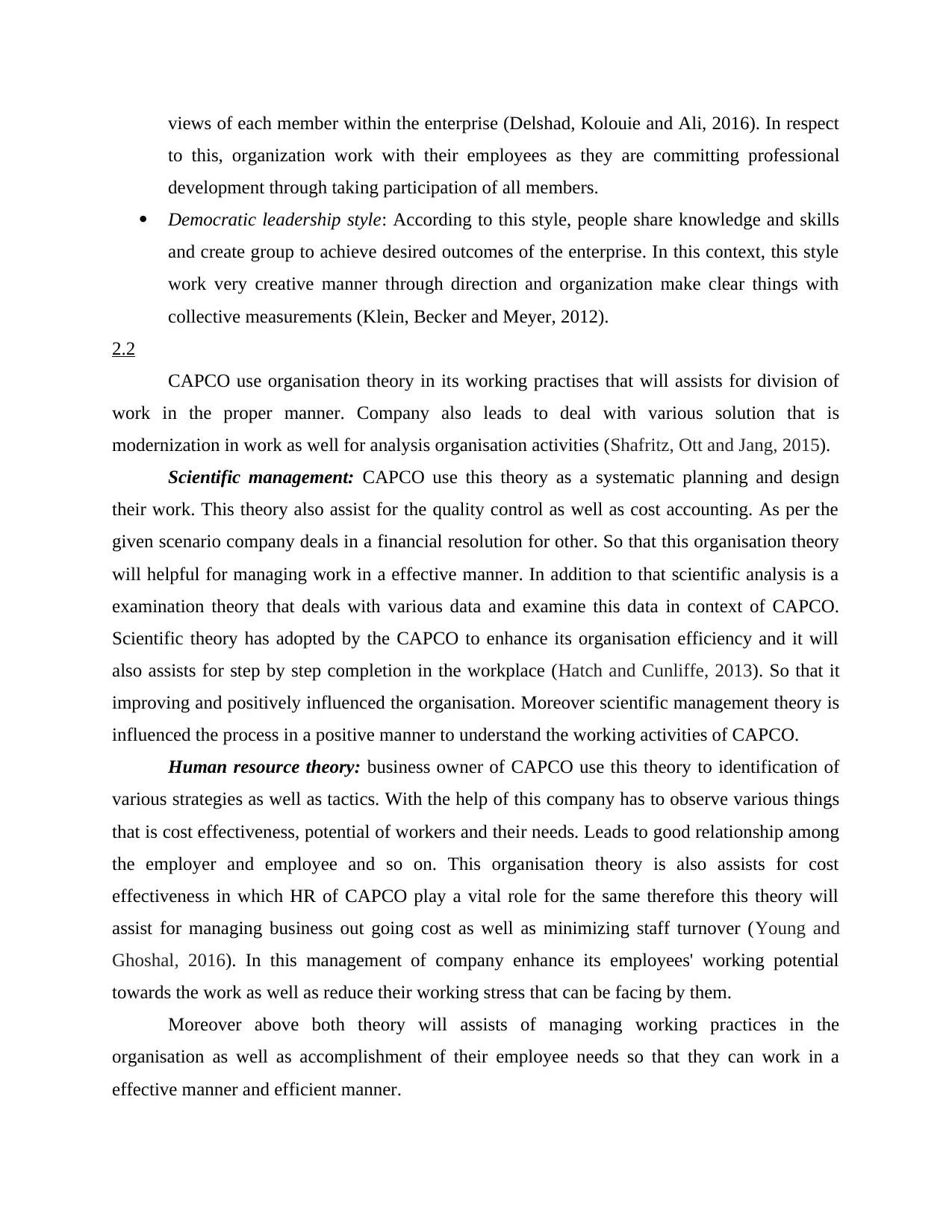
views of each member within the enterprise (Delshad, Kolouie and Ali, 2016). In respect
to this, organization work with their employees as they are committing professional
development through taking participation of all members.
Democratic leadership style: According to this style, people share knowledge and skills
and create group to achieve desired outcomes of the enterprise. In this context, this style
work very creative manner through direction and organization make clear things with
collective measurements (Klein, Becker and Meyer, 2012).
2.2
CAPCO use organisation theory in its working practises that will assists for division of
work in the proper manner. Company also leads to deal with various solution that is
modernization in work as well for analysis organisation activities (Shafritz, Ott and Jang, 2015).
Scientific management: CAPCO use this theory as a systematic planning and design
their work. This theory also assist for the quality control as well as cost accounting. As per the
given scenario company deals in a financial resolution for other. So that this organisation theory
will helpful for managing work in a effective manner. In addition to that scientific analysis is a
examination theory that deals with various data and examine this data in context of CAPCO.
Scientific theory has adopted by the CAPCO to enhance its organisation efficiency and it will
also assists for step by step completion in the workplace (Hatch and Cunliffe, 2013). So that it
improving and positively influenced the organisation. Moreover scientific management theory is
influenced the process in a positive manner to understand the working activities of CAPCO.
Human resource theory: business owner of CAPCO use this theory to identification of
various strategies as well as tactics. With the help of this company has to observe various things
that is cost effectiveness, potential of workers and their needs. Leads to good relationship among
the employer and employee and so on. This organisation theory is also assists for cost
effectiveness in which HR of CAPCO play a vital role for the same therefore this theory will
assist for managing business out going cost as well as minimizing staff turnover (Young and
Ghoshal, 2016). In this management of company enhance its employees' working potential
towards the work as well as reduce their working stress that can be facing by them.
Moreover above both theory will assists of managing working practices in the
organisation as well as accomplishment of their employee needs so that they can work in a
effective manner and efficient manner.
to this, organization work with their employees as they are committing professional
development through taking participation of all members.
Democratic leadership style: According to this style, people share knowledge and skills
and create group to achieve desired outcomes of the enterprise. In this context, this style
work very creative manner through direction and organization make clear things with
collective measurements (Klein, Becker and Meyer, 2012).
2.2
CAPCO use organisation theory in its working practises that will assists for division of
work in the proper manner. Company also leads to deal with various solution that is
modernization in work as well for analysis organisation activities (Shafritz, Ott and Jang, 2015).
Scientific management: CAPCO use this theory as a systematic planning and design
their work. This theory also assist for the quality control as well as cost accounting. As per the
given scenario company deals in a financial resolution for other. So that this organisation theory
will helpful for managing work in a effective manner. In addition to that scientific analysis is a
examination theory that deals with various data and examine this data in context of CAPCO.
Scientific theory has adopted by the CAPCO to enhance its organisation efficiency and it will
also assists for step by step completion in the workplace (Hatch and Cunliffe, 2013). So that it
improving and positively influenced the organisation. Moreover scientific management theory is
influenced the process in a positive manner to understand the working activities of CAPCO.
Human resource theory: business owner of CAPCO use this theory to identification of
various strategies as well as tactics. With the help of this company has to observe various things
that is cost effectiveness, potential of workers and their needs. Leads to good relationship among
the employer and employee and so on. This organisation theory is also assists for cost
effectiveness in which HR of CAPCO play a vital role for the same therefore this theory will
assist for managing business out going cost as well as minimizing staff turnover (Young and
Ghoshal, 2016). In this management of company enhance its employees' working potential
towards the work as well as reduce their working stress that can be facing by them.
Moreover above both theory will assists of managing working practices in the
organisation as well as accomplishment of their employee needs so that they can work in a
effective manner and efficient manner.
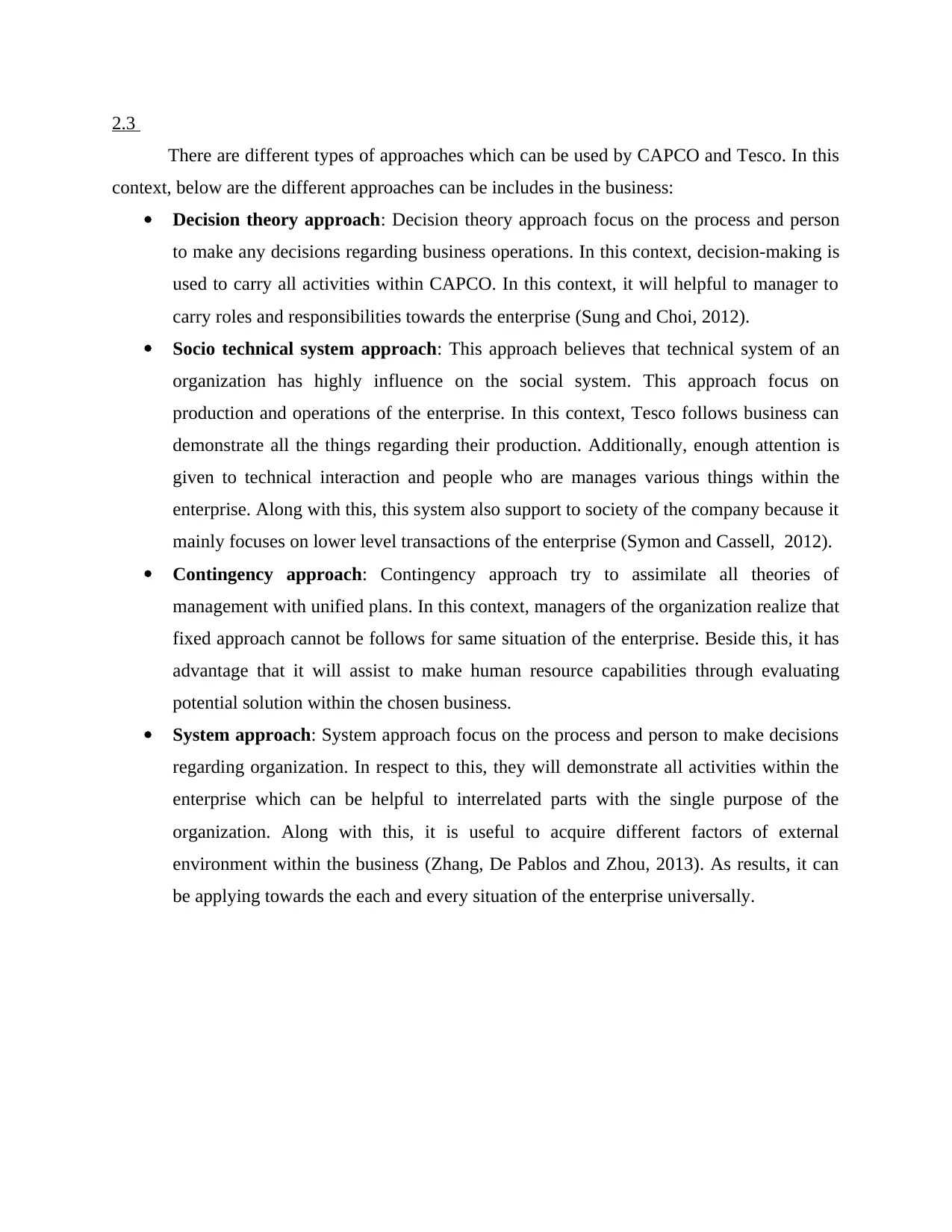
2.3
There are different types of approaches which can be used by CAPCO and Tesco. In this
context, below are the different approaches can be includes in the business:
Decision theory approach: Decision theory approach focus on the process and person
to make any decisions regarding business operations. In this context, decision-making is
used to carry all activities within CAPCO. In this context, it will helpful to manager to
carry roles and responsibilities towards the enterprise (Sung and Choi, 2012).
Socio technical system approach: This approach believes that technical system of an
organization has highly influence on the social system. This approach focus on
production and operations of the enterprise. In this context, Tesco follows business can
demonstrate all the things regarding their production. Additionally, enough attention is
given to technical interaction and people who are manages various things within the
enterprise. Along with this, this system also support to society of the company because it
mainly focuses on lower level transactions of the enterprise (Symon and Cassell, 2012).
Contingency approach: Contingency approach try to assimilate all theories of
management with unified plans. In this context, managers of the organization realize that
fixed approach cannot be follows for same situation of the enterprise. Beside this, it has
advantage that it will assist to make human resource capabilities through evaluating
potential solution within the chosen business.
System approach: System approach focus on the process and person to make decisions
regarding organization. In respect to this, they will demonstrate all activities within the
enterprise which can be helpful to interrelated parts with the single purpose of the
organization. Along with this, it is useful to acquire different factors of external
environment within the business (Zhang, De Pablos and Zhou, 2013). As results, it can
be applying towards the each and every situation of the enterprise universally.
There are different types of approaches which can be used by CAPCO and Tesco. In this
context, below are the different approaches can be includes in the business:
Decision theory approach: Decision theory approach focus on the process and person
to make any decisions regarding business operations. In this context, decision-making is
used to carry all activities within CAPCO. In this context, it will helpful to manager to
carry roles and responsibilities towards the enterprise (Sung and Choi, 2012).
Socio technical system approach: This approach believes that technical system of an
organization has highly influence on the social system. This approach focus on
production and operations of the enterprise. In this context, Tesco follows business can
demonstrate all the things regarding their production. Additionally, enough attention is
given to technical interaction and people who are manages various things within the
enterprise. Along with this, this system also support to society of the company because it
mainly focuses on lower level transactions of the enterprise (Symon and Cassell, 2012).
Contingency approach: Contingency approach try to assimilate all theories of
management with unified plans. In this context, managers of the organization realize that
fixed approach cannot be follows for same situation of the enterprise. Beside this, it has
advantage that it will assist to make human resource capabilities through evaluating
potential solution within the chosen business.
System approach: System approach focus on the process and person to make decisions
regarding organization. In respect to this, they will demonstrate all activities within the
enterprise which can be helpful to interrelated parts with the single purpose of the
organization. Along with this, it is useful to acquire different factors of external
environment within the business (Zhang, De Pablos and Zhou, 2013). As results, it can
be applying towards the each and every situation of the enterprise universally.
⊘ This is a preview!⊘
Do you want full access?
Subscribe today to unlock all pages.

Trusted by 1+ million students worldwide
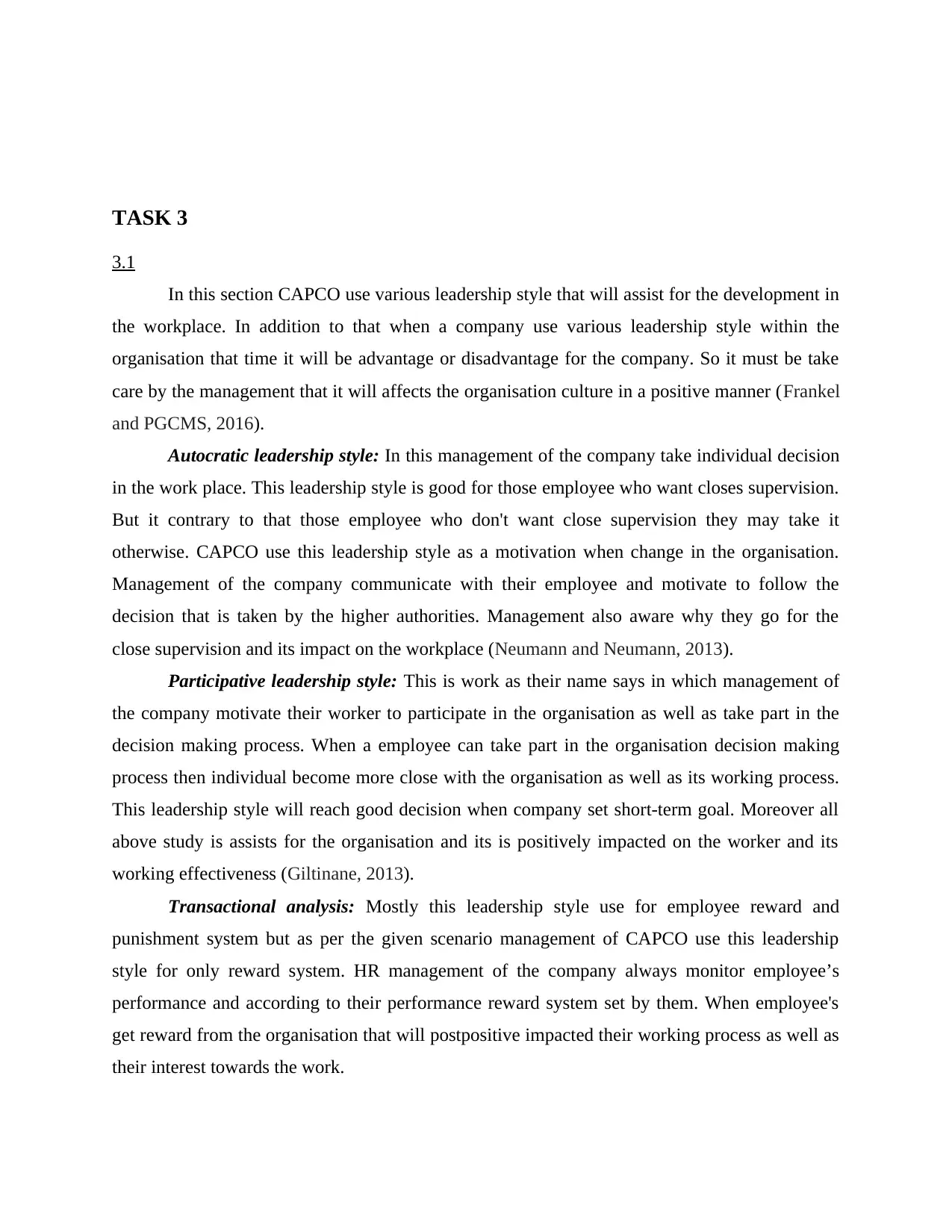
TASK 3
3.1
In this section CAPCO use various leadership style that will assist for the development in
the workplace. In addition to that when a company use various leadership style within the
organisation that time it will be advantage or disadvantage for the company. So it must be take
care by the management that it will affects the organisation culture in a positive manner (Frankel
and PGCMS, 2016).
Autocratic leadership style: In this management of the company take individual decision
in the work place. This leadership style is good for those employee who want closes supervision.
But it contrary to that those employee who don't want close supervision they may take it
otherwise. CAPCO use this leadership style as a motivation when change in the organisation.
Management of the company communicate with their employee and motivate to follow the
decision that is taken by the higher authorities. Management also aware why they go for the
close supervision and its impact on the workplace (Neumann and Neumann, 2013).
Participative leadership style: This is work as their name says in which management of
the company motivate their worker to participate in the organisation as well as take part in the
decision making process. When a employee can take part in the organisation decision making
process then individual become more close with the organisation as well as its working process.
This leadership style will reach good decision when company set short-term goal. Moreover all
above study is assists for the organisation and its is positively impacted on the worker and its
working effectiveness (Giltinane, 2013).
Transactional analysis: Mostly this leadership style use for employee reward and
punishment system but as per the given scenario management of CAPCO use this leadership
style for only reward system. HR management of the company always monitor employee’s
performance and according to their performance reward system set by them. When employee's
get reward from the organisation that will postpositive impacted their working process as well as
their interest towards the work.
3.1
In this section CAPCO use various leadership style that will assist for the development in
the workplace. In addition to that when a company use various leadership style within the
organisation that time it will be advantage or disadvantage for the company. So it must be take
care by the management that it will affects the organisation culture in a positive manner (Frankel
and PGCMS, 2016).
Autocratic leadership style: In this management of the company take individual decision
in the work place. This leadership style is good for those employee who want closes supervision.
But it contrary to that those employee who don't want close supervision they may take it
otherwise. CAPCO use this leadership style as a motivation when change in the organisation.
Management of the company communicate with their employee and motivate to follow the
decision that is taken by the higher authorities. Management also aware why they go for the
close supervision and its impact on the workplace (Neumann and Neumann, 2013).
Participative leadership style: This is work as their name says in which management of
the company motivate their worker to participate in the organisation as well as take part in the
decision making process. When a employee can take part in the organisation decision making
process then individual become more close with the organisation as well as its working process.
This leadership style will reach good decision when company set short-term goal. Moreover all
above study is assists for the organisation and its is positively impacted on the worker and its
working effectiveness (Giltinane, 2013).
Transactional analysis: Mostly this leadership style use for employee reward and
punishment system but as per the given scenario management of CAPCO use this leadership
style for only reward system. HR management of the company always monitor employee’s
performance and according to their performance reward system set by them. When employee's
get reward from the organisation that will postpositive impacted their working process as well as
their interest towards the work.
Paraphrase This Document
Need a fresh take? Get an instant paraphrase of this document with our AI Paraphraser
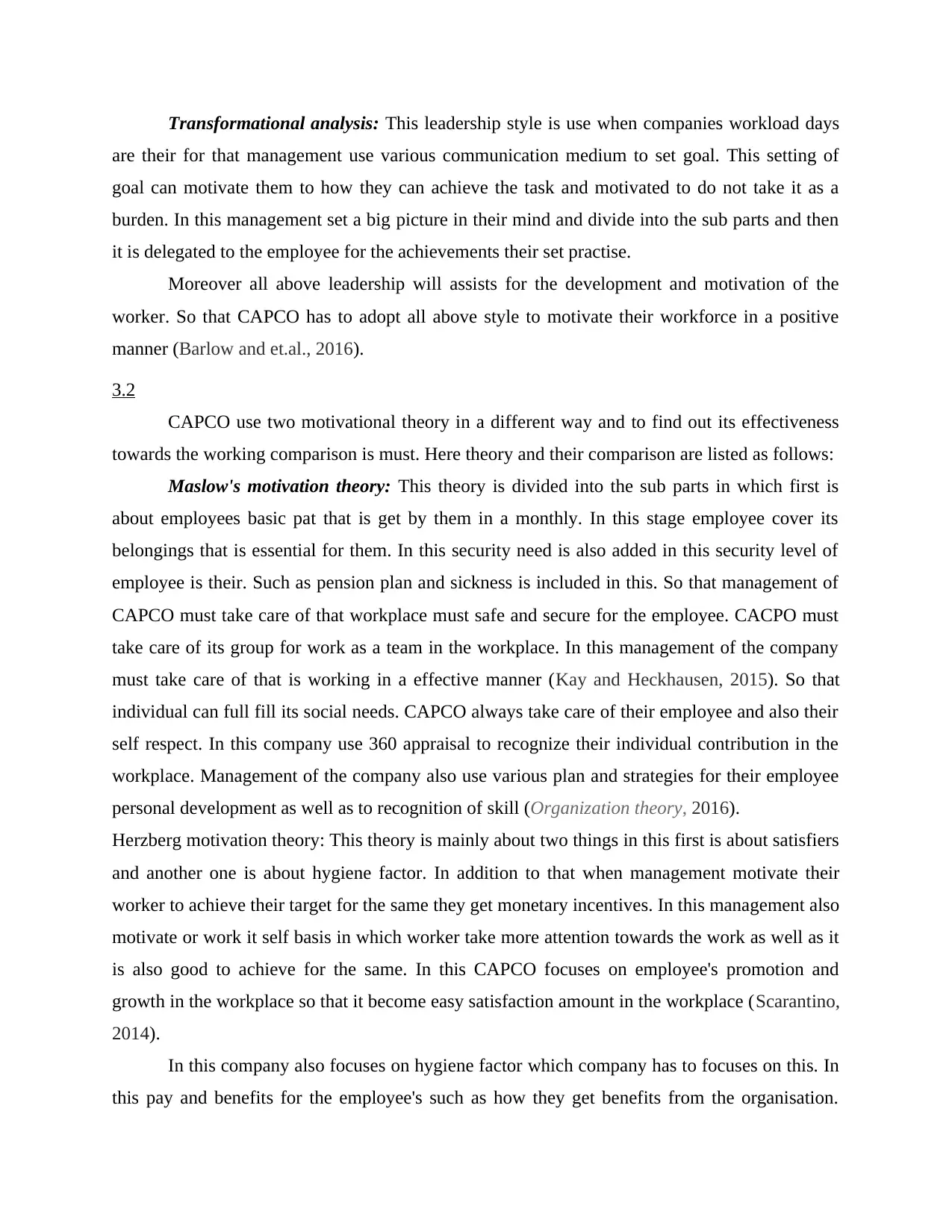
Transformational analysis: This leadership style is use when companies workload days
are their for that management use various communication medium to set goal. This setting of
goal can motivate them to how they can achieve the task and motivated to do not take it as a
burden. In this management set a big picture in their mind and divide into the sub parts and then
it is delegated to the employee for the achievements their set practise.
Moreover all above leadership will assists for the development and motivation of the
worker. So that CAPCO has to adopt all above style to motivate their workforce in a positive
manner (Barlow and et.al., 2016).
3.2
CAPCO use two motivational theory in a different way and to find out its effectiveness
towards the working comparison is must. Here theory and their comparison are listed as follows:
Maslow's motivation theory: This theory is divided into the sub parts in which first is
about employees basic pat that is get by them in a monthly. In this stage employee cover its
belongings that is essential for them. In this security need is also added in this security level of
employee is their. Such as pension plan and sickness is included in this. So that management of
CAPCO must take care of that workplace must safe and secure for the employee. CACPO must
take care of its group for work as a team in the workplace. In this management of the company
must take care of that is working in a effective manner (Kay and Heckhausen, 2015). So that
individual can full fill its social needs. CAPCO always take care of their employee and also their
self respect. In this company use 360 appraisal to recognize their individual contribution in the
workplace. Management of the company also use various plan and strategies for their employee
personal development as well as to recognition of skill (Organization theory, 2016).
Herzberg motivation theory: This theory is mainly about two things in this first is about satisfiers
and another one is about hygiene factor. In addition to that when management motivate their
worker to achieve their target for the same they get monetary incentives. In this management also
motivate or work it self basis in which worker take more attention towards the work as well as it
is also good to achieve for the same. In this CAPCO focuses on employee's promotion and
growth in the workplace so that it become easy satisfaction amount in the workplace (Scarantino,
2014).
In this company also focuses on hygiene factor which company has to focuses on this. In
this pay and benefits for the employee's such as how they get benefits from the organisation.
are their for that management use various communication medium to set goal. This setting of
goal can motivate them to how they can achieve the task and motivated to do not take it as a
burden. In this management set a big picture in their mind and divide into the sub parts and then
it is delegated to the employee for the achievements their set practise.
Moreover all above leadership will assists for the development and motivation of the
worker. So that CAPCO has to adopt all above style to motivate their workforce in a positive
manner (Barlow and et.al., 2016).
3.2
CAPCO use two motivational theory in a different way and to find out its effectiveness
towards the working comparison is must. Here theory and their comparison are listed as follows:
Maslow's motivation theory: This theory is divided into the sub parts in which first is
about employees basic pat that is get by them in a monthly. In this stage employee cover its
belongings that is essential for them. In this security need is also added in this security level of
employee is their. Such as pension plan and sickness is included in this. So that management of
CAPCO must take care of that workplace must safe and secure for the employee. CACPO must
take care of its group for work as a team in the workplace. In this management of the company
must take care of that is working in a effective manner (Kay and Heckhausen, 2015). So that
individual can full fill its social needs. CAPCO always take care of their employee and also their
self respect. In this company use 360 appraisal to recognize their individual contribution in the
workplace. Management of the company also use various plan and strategies for their employee
personal development as well as to recognition of skill (Organization theory, 2016).
Herzberg motivation theory: This theory is mainly about two things in this first is about satisfiers
and another one is about hygiene factor. In addition to that when management motivate their
worker to achieve their target for the same they get monetary incentives. In this management also
motivate or work it self basis in which worker take more attention towards the work as well as it
is also good to achieve for the same. In this CAPCO focuses on employee's promotion and
growth in the workplace so that it become easy satisfaction amount in the workplace (Scarantino,
2014).
In this company also focuses on hygiene factor which company has to focuses on this. In
this pay and benefits for the employee's such as how they get benefits from the organisation.
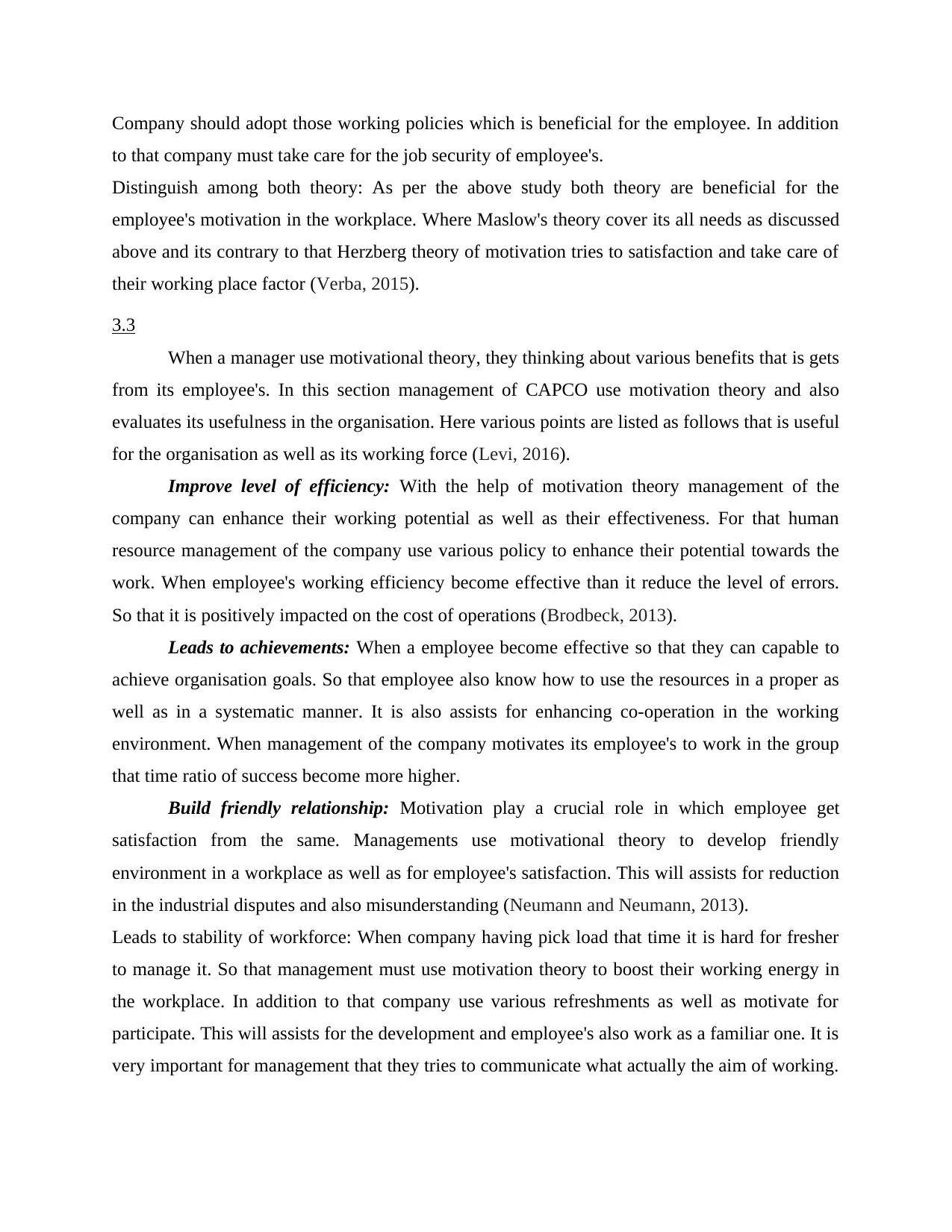
Company should adopt those working policies which is beneficial for the employee. In addition
to that company must take care for the job security of employee's.
Distinguish among both theory: As per the above study both theory are beneficial for the
employee's motivation in the workplace. Where Maslow's theory cover its all needs as discussed
above and its contrary to that Herzberg theory of motivation tries to satisfaction and take care of
their working place factor (Verba, 2015).
3.3
When a manager use motivational theory, they thinking about various benefits that is gets
from its employee's. In this section management of CAPCO use motivation theory and also
evaluates its usefulness in the organisation. Here various points are listed as follows that is useful
for the organisation as well as its working force (Levi, 2016).
Improve level of efficiency: With the help of motivation theory management of the
company can enhance their working potential as well as their effectiveness. For that human
resource management of the company use various policy to enhance their potential towards the
work. When employee's working efficiency become effective than it reduce the level of errors.
So that it is positively impacted on the cost of operations (Brodbeck, 2013).
Leads to achievements: When a employee become effective so that they can capable to
achieve organisation goals. So that employee also know how to use the resources in a proper as
well as in a systematic manner. It is also assists for enhancing co-operation in the working
environment. When management of the company motivates its employee's to work in the group
that time ratio of success become more higher.
Build friendly relationship: Motivation play a crucial role in which employee get
satisfaction from the same. Managements use motivational theory to develop friendly
environment in a workplace as well as for employee's satisfaction. This will assists for reduction
in the industrial disputes and also misunderstanding (Neumann and Neumann, 2013).
Leads to stability of workforce: When company having pick load that time it is hard for fresher
to manage it. So that management must use motivation theory to boost their working energy in
the workplace. In addition to that company use various refreshments as well as motivate for
participate. This will assists for the development and employee's also work as a familiar one. It is
very important for management that they tries to communicate what actually the aim of working.
to that company must take care for the job security of employee's.
Distinguish among both theory: As per the above study both theory are beneficial for the
employee's motivation in the workplace. Where Maslow's theory cover its all needs as discussed
above and its contrary to that Herzberg theory of motivation tries to satisfaction and take care of
their working place factor (Verba, 2015).
3.3
When a manager use motivational theory, they thinking about various benefits that is gets
from its employee's. In this section management of CAPCO use motivation theory and also
evaluates its usefulness in the organisation. Here various points are listed as follows that is useful
for the organisation as well as its working force (Levi, 2016).
Improve level of efficiency: With the help of motivation theory management of the
company can enhance their working potential as well as their effectiveness. For that human
resource management of the company use various policy to enhance their potential towards the
work. When employee's working efficiency become effective than it reduce the level of errors.
So that it is positively impacted on the cost of operations (Brodbeck, 2013).
Leads to achievements: When a employee become effective so that they can capable to
achieve organisation goals. So that employee also know how to use the resources in a proper as
well as in a systematic manner. It is also assists for enhancing co-operation in the working
environment. When management of the company motivates its employee's to work in the group
that time ratio of success become more higher.
Build friendly relationship: Motivation play a crucial role in which employee get
satisfaction from the same. Managements use motivational theory to develop friendly
environment in a workplace as well as for employee's satisfaction. This will assists for reduction
in the industrial disputes and also misunderstanding (Neumann and Neumann, 2013).
Leads to stability of workforce: When company having pick load that time it is hard for fresher
to manage it. So that management must use motivation theory to boost their working energy in
the workplace. In addition to that company use various refreshments as well as motivate for
participate. This will assists for the development and employee's also work as a familiar one. It is
very important for management that they tries to communicate what actually the aim of working.
⊘ This is a preview!⊘
Do you want full access?
Subscribe today to unlock all pages.

Trusted by 1+ million students worldwide
1 out of 24
Related Documents
Your All-in-One AI-Powered Toolkit for Academic Success.
+13062052269
info@desklib.com
Available 24*7 on WhatsApp / Email
![[object Object]](/_next/static/media/star-bottom.7253800d.svg)
Unlock your academic potential
Copyright © 2020–2025 A2Z Services. All Rights Reserved. Developed and managed by ZUCOL.





